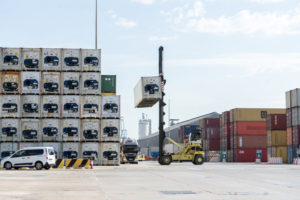
The idle fleet continues to grow due to the effects of the Covid-19 crisis, reaching 2.65 million TEUs
The Western Mediterranean reflects a 3.28% growth in freight rates, breaking the decline of the previous two months
València, June 8th, 2020.- The crisis caused by the Covid-19 pandemic continues to mark the situation of world economic activity. The index produced by Valencia Containerised Freight Index (VCFI) reflects a slowdown in May compared to previous months, which is reflected in a 6.64% drop. The accumulated index stands at 1,245, 86 points, almost 200 points higher than the data for May 2019. The idle fleet continued growth, reaching 11.3% and 2.65 million TEUs. However, the month of May shows some positive signs in some European countries in the recovery of economic activity which are reflected in the increase in the price of oil in comparison with the previous month.
The Valencia Containerised Freight Index (VCFI) shows a slowdown of 6.64% in May to 1,245.86 points, a reduction that marks the end of the accumulated growth trend of the previous two month (March and April). The crisis caused by the Covid-19 pandemic continued to affect the pre-crisis levels of activity while it is certainly true that, in part, European countries are showing a certain improvement in industrial and retail activity. The figure for accumulated growth since the start of the VCFI series in January 2018 stands at 24.59%.
Evidence of the current market situation, characterised by low demand, can be seen in the continued growth of the idle fleet, which continues to reach record highs, touching 524 units and 2.65 million TEU, which is equivalent to 11.3% of the total active float (Alphaliner). The significant portion of this figure corresponds to the vessels idle for the installation of scrubbers, accounting for 13.5% of the total. To adjust to this exceptional situation arising from the Covid-19 crisis, shipping companies have restructured their offering of maritime services and amended their sailings schedules, frequencies and routes with the aim of adapting to the needs of the market and adjusting their capacity to demand. Consequently, blank sailings remained high in May and are expected to continue to remain high over the coming months, with international trade at a low ebb (Alphaliner).
In this scenario, the fall in the VCFI general index in the month of May is a good barometer of the health of the container shipping market as a whole, with 11 of the 13 areas studied in the VCFI also showing a reduction in freight levels compared to the previous month. The markets experiencing the most dramatic reductions were the Indian Subcontinent (-15.75%), the United States and Canada (-9.90%), Africa West Coast (-8.36%) and the Middle East (-6.47%).
Western Mediterranean
Turning to freights with the Western Mediterranean, freights grew by 3.28% compared to the previous month, with index reaching a value of 1,065.90. The performance of this region is in direct contrast to the above, as one of the few that went into the month with two consecutive months of contraction in freight levels behind it, influenced largely by the falling cost of fuel, the changing course of which could also be behind this upsurge. How demand performs over the coming months will decide whether this is a once-off movement or whether it will become a consolidated trend in the region.
Far East
As for the Far East, after a significant growth in the last two months (42.42% in March and 22.69% in April), May saw a contraction of 6.05%. The VCFI regional sub-index for the Far East stands at 1,726.85 points. The situation in Chinese ports, demand and the restructuring of many lines to the Far East (temporary suspension of lines, blank sailings and change to itineraries and port calls) caused growth in freights in previous months. However, despite that restructuring of the offer continuing, the characteristic imbalance of the routes between Europe/Mediterranean and the Far East poses different situations depending on the direction of traffic, which in this case translates into a slight reduction in freights.
For more information, you can check this link

